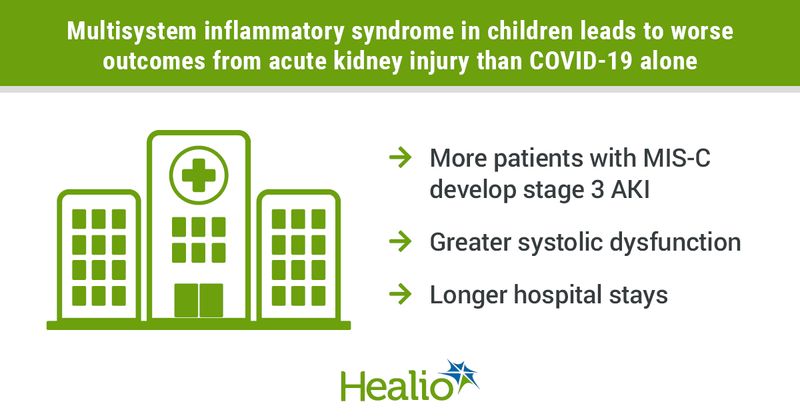Children with multisystem inflammatory syndrome due to COVID-19 at greater risk for AKI
Pediatric patients with COVID-19 who also developed multisystem inflammatory syndrome in children had a higher risk for AKI and subsequent adverse outcomes, study results showed.
“The sudden surge of COVID-19 in children and development of the mysterious [multisystem inflammatory syndrome in children] MIS-C presented clinicians a new challenge during the height of the pandemic,” principal investigator Christine B. Sethna, MD, associate professor at the Feinstein Institutes for Medical Research, said in a related press release. “It is important for doctors on the frontlines and those caring for these children after discharge to understand the connection between kidney injury and COVID-19 or MIS-C.”

For the study, researchers included patients aged 18 years or younger who were hospitalized at one of four New York hospitals in the Northwell Health System between March and August 2020 (97 with acute COVID-19; 55 with MIS-C). MIS-C was determined using the CDC definition, described here as “children who presented with fevers, significant evidence of inflammation, evidence of [at least two] organ dysfunction, and tested positive for current or recent SARS-CoV-2 infection or had serologic confirmation of exposure to COVID-19 within 4 weeks of symptom onset.”
Researchers found AKI occurred in 11.8% of all patients (8.2% of those with COVID-19 vs. 18.2% in those with MIS-C); AKI was associated with lower serum albumin levels and higher white blood cell counts, “which may reflect the inflammatory cascade’s complex role in development and perpetuation of AKI,” the researchers wrote.
Further results showed patients with MIS-C developed more severe AKI than did those with COVID-19 (for instance, 1% of patients with COVID-19 had stage 3 AKI vs. 7.3% with MIS-C).
Regarding outcomes for patients who developed AKI, researchers found patients with MIS-C experienced greater systolic dysfunction (80% vs. 49%) and hospital stays that were 8.4 days longer than patients with COVID-19.
“The significant association of lower median left ventricular ejection fraction, systolic dysfunction, and AKI in MIS-C patients may indicate that low cardiac output also contributed to AKI,” the researchers wrote of the observed systolic dysfunction. “More important, not all patients with left ventricular dysfunction and/or shock, requiring vasoactives, developed AKI, suggesting multifactorial mechanisms of injury.”
Abby Basalely, MD, assistant professor at the Donald and Barbara Zucker School of Medicine at Hofstra/Northwell and first author on the paper, commented on implications of the findings in the release.
“This research reveals the risk of kidney injury, new clues into how COVID-19 progresses in children and ultimately how we can treat the disease and its related complications,” she said.

